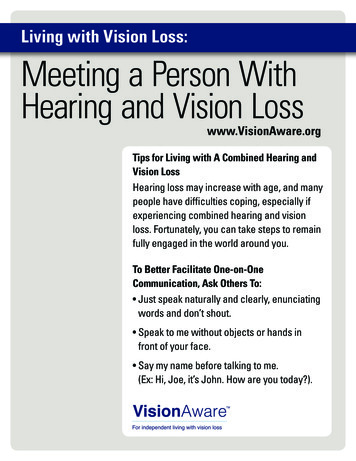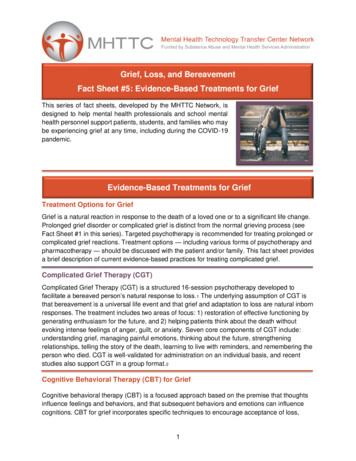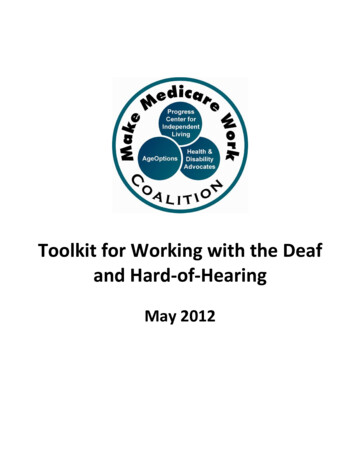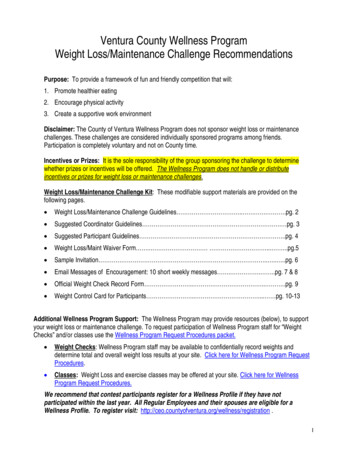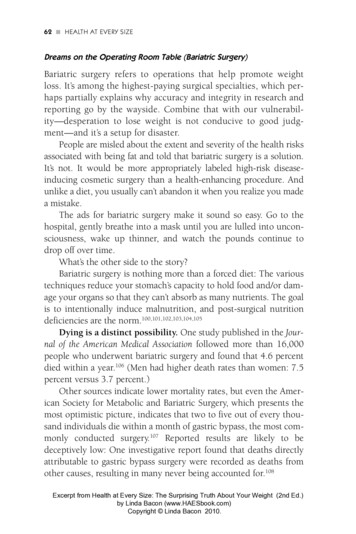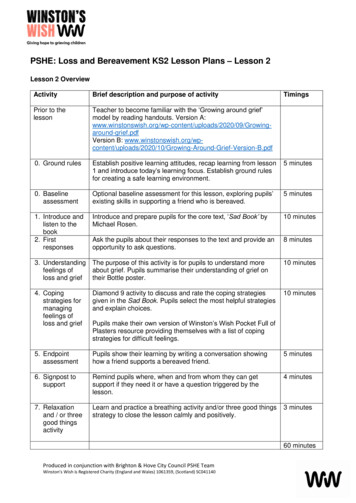
Transcription
PSHE: Loss and Bereavement KS2 Lesson Plans – Lesson 2Lesson 2 OverviewActivityBrief description and purpose of activityTimingsPrior to thelessonTeacher to become familiar with the ‘Growing around grief’model by reading handouts. Version Growingaround-grief.pdfVersion B: wing-Around-Grief-Version-B.pdf0. Ground rulesEstablish positive learning attitudes, recap learning from lesson1 and introduce today’s learning focus. Establish ground rulesfor creating a safe learning environment.5 minutes0. BaselineassessmentOptional baseline assessment for this lesson, exploring pupils’existing skills in supporting a friend who is bereaved.5 minutes1. Introduce andlisten to thebook2. FirstresponsesIntroduce and prepare pupils for the core text, ‘Sad Book’ byMichael Rosen.10 minutesAsk the pupils about their responses to the text and provide anopportunity to ask questions.8 minutes3. Understanding The purpose of this activity is for pupils to understand morefeelings ofabout grief. Pupils summarise their understanding of grief onloss and grieftheir Bottle poster.10 minutes4. Copingstrategies formanagingfeelings ofloss and griefDiamond 9 activity to discuss and rate the coping strategiesgiven in the Sad Book. Pupils select the most helpful strategiesand explain choices.10 minutes5. EndpointassessmentPupils show their learning by writing a conversation showinghow a friend supports a bereaved friend.5 minutes6. Signpost tosupportRemind pupils where, when and from whom they can getsupport if they need it or have a question triggered by thelesson.4 minutes7. Relaxationand / or threegood thingsactivityLearn and practice a breathing activity and/or three good thingsstrategy to close the lesson calmly and positively.3 minutesPupils make their own version of Winston’s Wish Pocket Full ofPlasters resource providing themselves with a list of copingstrategies for difficult feelings.60 minutesProduced in conjunction with Brighton & Hove City Council PSHE TeamWinston’s Wish is Registered Charity (England and Wales) 1061359, (Scotland) SC041140
Lesson 2 detailed lesson planKey Stage 2Lesson titleLesson 2 Coping strategies for managing feelings of loss and griefLesson length60 minutesIntroductionThis is the second in a series of two lessons for Year 4, 5 or 6 (Key Stage 2)loss and bereavement. This lesson explores coping strategies to managefeelings of loss and grief. The lesson uses a book to introduce this sensitivesubject. This lesson should be taught as part of a planned programme ofPSHE.The following messages can be used to support the lesson: Nothing that is alive goes on living for ever Sometimes something that is alive gets ill and gets better Sometimes an illness means something alive dies Sometimes something that was alive dies because it has become old Different animals and plants have different lifetimes It is normal to feel sad when someone or a pet dies It is good to be able to talk about difficult feelings and experiences.Safe learningenvironmentTo support a safe learning environment for this lesson: Read the Guide to Teaching and Learning about Loss andBereavement in PSHE lessons that accompanies these lessons It is recommended that teachers delivering these lessons havereceived some training – see Section 2.7 of the Guide to Teachingand Learning Ensure you are aware which pupils may need extra support in thislesson e.g. pupils who have been bereaved of a family member In order to keep everyone feeling safe during the baseline activity askpupils where they would get help for sad feelings, rather thanexploring what these sad feelings might be about. Consider using a question or thought box for pupils to safely reflect onthe lesson or ask questions. Set this up at the beginning of the lessonand explain who will see the questions and how they will beresponded to. Pupils could sit in a circle recapping their learning and the discussionsection of the lesson. This would mean that any comments orquestions would be shared as a class and allow the class teacher tocarefully maintain the safe learning environment. They could createtheir ‘plasters’ resource at their tables. If possible, have a second adult in the room.Look at the two ‘Growing Around Grief’ handouts and select the mostappropriate for your class. Version A: wing-around-grief.pdfVersion B: wing-Around-Grief-Version-B.pdfProduced in conjunction with Brighton & Hove City Council PSHE TeamWinston’s Wish is Registered Charity (England and Wales) 1061359, (Scotland) SC041140
Resourcesrequired Text: Sad Book by Michael Rosen or similar text or watch onlineBottle posters from last lessonLook at the two ‘Growing Around Grief’ handouts and, if desired,select the most appropriate one(s) for your classVersion A: wing-around-grief.pdfVersion B: wing-Around-Grief-Version-B.pdfA mug, a mixing bowl, a waste paper basket or bucket PLUS a tennisball or a ball made from coloured rubber bandsCopies of Winston’s Wish ‘A Pocket Full of Plasters’ resource ifpossible. (These need to be purchased from Winston’s Wishwww.winstonswish.org One per group would be sufficient)‘My Pocket Full of Plasters’ template copies for each te.pdfDiamond 9 Cards – one for each group PSHE-KS2-L2-A4-Diamond9-cards.pdfColoured crayons or pencilsKS2 Lesson 2 PowerPoint slides to support lesson deliveryThis lessoncontributes to thefollowingobjectives in thePSHEAssociationProgramme ofStudyH14. how and when to seek support, including which adults to speak to in andoutside school, if they are worried about their healthH17. to recognise that feelings can change over time and range in intensityH18. about everyday things that affect feelings and the importance ofexpressing feelingsH19. a varied vocabulary to use when talking about feelings; about how toexpress feelings in different waysH20. strategies to respond to feelings, including intense or conflictingfeelings; how to manage and respond to feelings appropriately andproportionately in different situationsH23. about change and loss, including death, and how these can affectfeelings; ways of expressing and managing grief and bereavementLearningobjectiveLearningoutcomesPupils will learn more about grief, and explore some strategies to cope with itKey WordsDead, loss, goodbye, sad, cross, angry, upset, comfort, helps, feel better,cope, manage, strategy, griefDifferentiationActivity 3 – objects on cards will support with discussionExtension activity – give out copies of the sad poem from Sad Book and askpupils to write another verse.Assessment options provided for supporting and extending the learning.I can recognise and name feelings associated with sadness and griefI can describe what I would do to support a friend who felt sadI can identify three ways of coping with loss or griefI can identify who I can ask for support with difficult feelingsProduced in conjunction with Brighton & Hove City Council PSHE TeamWinston’s Wish is Registered Charity (England and Wales) 1061359, (Scotland) SC041140
Activity 0Introduction to thelesson andground rulesIntroduce the learning question: How can we handle our feelings about loss?(PowerPoint Slide 2).Revisit the ground rules established in the last lesson and remind pupilsabout the question box. (PowerPoint Slide 3). Explain that this lessoncontinues learning about loss and bereavement.Acknowledge that there will be pupils in the class who have experienced thedeath of a pet or family member. Explain to pupils that the lesson is going tobe about developing ways to manage difficult feelings including loss and griefas all of us will have these feelings at some point.Recap learning from the previous lesson. (PowerPoint Slide 4).OptionalbaselineassessmentLesson 1 provided a baseline assessment that could be used for both lessonswhich explored how pupils would support a friend who felt sad. In this lesson,if the teacher thought appropriate, a similar question could be posed butfocusing on sadness because of a bereavement.The teacher can begin by reviewing learning from the previous lesson andremind pupils of the experience of the child in the story, ‘The Heart and theBottle’. Ask pupils to think about this child and with their talk partner to brieflydiscuss: What would you do or say to a friend who was feeling sad becausesomeone had died?Class teacher can ask for feedback and record on the flip chart. This providesa baseline assessment. By the end of the lesson, pupils understanding ofwhat to say and do to help a friend and to help themselves should have beenextended.Activity 1Introduction andlistening to thestoryIntroduce the story: ‘Sad Book’ by Michael Rosen. Explain that, in this book,Michael Rosen talks about two people close to him who have died and sharessome of his feelings about what happened and some strategies he uses forcoping with these feelings of grief.Explain that listening to this book may cause strong feelings, that this is OKand that they can talk about these feelings with you or another trusted adult.(PowerPoint Slide 5).Read ‘Sad Book’ by Michael Rosen (or watch and listen to the story online.)Produced in conjunction with Brighton & Hove City Council PSHE TeamWinston’s Wish is Registered Charity (England and Wales) 1061359, (Scotland) SC041140
Activity 2First responsesAsk pupils for their first responses or reactions to the text. Discussion couldtake place with pairs first and then with the whole class. The purpose of thediscussion is to check understanding of the book and begin to draw out somekey messages. There is also an opportunity for pupils to ask questions andget clarification.Questions that could be asked may include: (PowerPoint Slide 6) What did you like about the book?Was there anything you didn’t like about the book?What would you say about the book to someone who has not read it?What have you learned from the book?Was there anything that surprised you in the book?It is possible pupils will talk about strong feelings, perhaps feeling sorry forMichael, or scared that they might lose someone close to them. For thosewho have lost someone it may bring those memories back. Acknowledgethese feelings and remind that it’s OK to feel these feelings. Remind pupils ofwho they can talk to further if they want to. Follow-up with any such pupiloutside of lesson, if needed, including discussing with the safeguarding lead.Pupils may ask some questions about death and dying, including whyMichael Rosen’s son died. You can explain that he died from a very seriousillness (meningitis) but this is very rare and there are treatments and vaccinesagainst some forms of this illness. Usually people die when they are old.These scripts may be helpful: Nothing that is alive goes on living foreverSometimes something that is alive gets ill and gets betterSometimes an illness means something alive diesSometimes something that was alive dies because it has become oldDifferent animals and plants have different lifetimesIt is normal to feel sad when someone or a pet diesIt is good to be able to talk about difficult feelings and experiences.It is recommended that class teachers prepare for answering questions byreading the Guide to Teaching and Learning about Loss and Bereavement inPSHE lessons.Activity 3Understandingfeelings of lossand griefExplain to pupils that there are psychologists who have identified theoriesabout death and grief that can also help us to understand our feelings(PowerPoint Slide 7). Explain the idea of ‘Growing around Grief’ (Tonkin’smodel) using one or both handouts as appropriate to your pupils(Version A: owingaround-grief.pdfVersion B: owingAround-Grief-Version-B.pdf)These are illustrated on two slides: please choose the most appropriate foryour explanation (PowerPoint Slide 8 and Slide 9).It would help if you feel able to demonstrate this theory using a tennis ball orball of coloured elastic bands and a mug, a mixing bowl and a waste paperProduced in conjunction with Brighton & Hove City Council PSHE TeamWinston’s Wish is Registered Charity (England and Wales) 1061359, (Scotland) SC041140
basket (or equivalents). The explanation you could use is on Version A of thehandout.Focus here on positive messages that it does get easier with help.Give out the pupils’ Bottle posters from last lesson and ask if they can link thislearning about theories to the story. The key message here is that out of griefand difficult times we can find a way to continue to experience curiosity andjoy.Ask pupils to work individually to reflect on what they have learned about griefthat they did not already know. Pupils can add this to the box (‘What I havelearned about loss and grief’) on their Bottle poster. This can be used as anindividual assessment of learning.Activity 4Coping strategies– for others andmyselfRemind pupils that Michael Rosen had a number of ways of dealing with hisgrief (PowerPoint Slide 10). Give out sets of Diamond 9 cards to groups of3 or 4 pupils.Ask them to organise them into a Diamond 9 (example on PowerPoint Slide11) with the strategies that they think would have been the most helpful toMichael. The strategy that they think would work best goes at the top with thestrategy they think is the least helpful at the bottom. To do this they will needto talk with each other about what is good about the strategy, how it might behelpful and what the issues might be. Pupils can be invited to replace any ofMichael’s ideas with their own strategies (using the blank boxes) and addthese to the Diamond 9.A representative from each group can then feedback their top strategy.Following this activity, pupils are asked to work on their own to develop a setof ideas that they can use if they are feeling a difficult feeling such as grief orsadness.Explain that childhood bereavement charity Winston’s Wish suggests using ‘APocket Full of Plasters’ as a way of coping with painful memories (pleasenote these are metaphorical plasters and aren’t real plasters). It has 10'plasters' of advice that young people can stick on when they are hurting. Ifpossible, give pupils the Winston’s Wish A Pocket Full of Plasters resource toread and review. (PowerPoint Slide 12).Give out the Pocket Full of Plasters template and ask pupils to write ideasfor things that may be helpful to them that they can ‘stick on’ to help them withtheir feelings. Explain that they can choose from Michael’s ideas, the PocketFull of Plasters and add some of their own. The teacher could give some oftheir examples: e.g. walk my dog, cook a meal, remember that feelings pass,play football, talk to my friend.These do not have to be shared and in fact might work better for the pupils ifit is set up as an activity that is just for them and they can take it away withthem.Produced in conjunction with Brighton & Hove City Council PSHE TeamWinston’s Wish is Registered Charity (England and Wales) 1061359, (Scotland) SC041140
Activity 5Assessment oflearning.Explain that in this final activity they have the chance to use all their learningover the last two lessons. Read this scenario (PowerPoint Slide 13) topupils:Aisha has a friend called Zuzanna. Zuzanna’s granny died a month ago. Thefuneral was in Poland and Zuzanna did not go. Aisha notices that Zuzanna isby herself in the playground and looks very sad.Divide pupils into mixed ability pairs to write a conversation or conversationsthat show what Zuzanna is feeling and what Aisha says and does to help her.It is suggested that this is a written activity rather than a role play to give timeand space for careful thought. Pupils could be supported with a writing frameif needed or one or both examples could be used.Example 1 – Talking about feelings.Aisha: Hi Zuzanna, are you OK, you are looking a bit sad?Zuzanna: I am feeling sad (Zuzanna looks as if she is going to cry). Mygranny died and my mum has gone to the funeral in Poland and I miss mygranny and my mum.Aisha: I am very sorry to hear that. It must be very difficult for you. Did yousee your granny a lot?Zuzanna: I talked to her every week on FaceTime and we went to visit everysummer. I can’t believe I will never see her again.Aisha: That must be hard. Would you like a hug?Zuzanna: Yes please. Can I play with you?Aisha: Yes of course. Remember to tell our teacher if your sad feelings makeit hard to do your work.Example 2 – Talking about feelings, the next dayAisha: How are you feeling today?Zuzanna: I feel better but sometimes I still feel very sad.Aisha: Do you remember in PSHE we talked about things that can help whenwe have difficult feelings?Zuzanna: No I don’t remember.Aisha: When I feel sad I listen to some happy music or read a book I like.Zuzanna: That’s a good idea. I sometimes breathe in and out slowly.Aisha: That’s good. Do you have anyone you can tell about your sadfeelings?Produced in conjunction with Brighton & Hove City Council PSHE TeamWinston’s Wish is Registered Charity (England and Wales) 1061359, (Scotland) SC041140
Zuzanna: I don’t want to tell my mum because she is very sad.Aisha: I think your mum would want to know.Zuzanna: Maybe, thank you. It’s our turn to go into dinner now.Pupils could be invited to read out their conversations with the teacherscribing all the strategies used or suggested to support someone else.The conversations could be teacher assessed against the learning outcomesfor the lesson.Finally, pupils are invited to choose a strategy that they will try next time afriend is feeling sad or another difficult feeling.Activity 6Signpost tosupportRemind the pupils that if this lesson has made them feel sad or if they have aquestion, who they can talk to, and importantly when they can do this. Thesetrusted people could include their teachers, their parents and carers or otheradults in their life. Explain that sometimes it’s helpful to talk with peopleoutside of our family, friends or school and signpost to ChildLine andWinston’s Wish. (PowerPoint Slide 14).Make a link to protective behaviour message: We can talk with someoneabout anything, even if it feels awful or smallActivity 7Relaxationactivity and / orgratitude activityto build wellbeing.Teach the pupils a breathing activity, for example star breathing(see PowerPoint Slide 15) to end the lesson calmly.If time, or instead of relaxation strategy, highlight the gratitude strategydescribed in Sad Book (PowerPoint Slide 16) and recap the example (beinggrateful for a roast dinner, or grateful they were able to cook it).Explain that scientists have found out that feeling grateful can help us to growour well-being and feel happier. These things that we feel grateful for can bereally small, simple things. The class teacher can model appropriateexamples (e.g. a sunny day, a smile from a friend and a delicious cup ofcoffee.)Ask pupils to individually consider three good things that have happened tothem today.Embedding andextendinglearningContinue the ‘Three Good things’ practice for a week by asking pupils todiscuss one or more ‘good thing(s)’ with their partners at the end of the day.Pupil ideas could then be added to a class display.Produced in conjunction with Brighton & Hove City Council PSHE TeamWinston’s Wish is Registered Charity (England and Wales) 1061359, (Scotland) SC041140
Lesson title Lesson 2 Coping strategies for managing feelings of loss and grief Lesson length 60 minutes Introduction This is the second in a series of two lessons for Year 4, 5 or 6 (Key Stage 2) loss and bereavement. This lesson explores coping strategies to manage feelings of loss and grief. The

